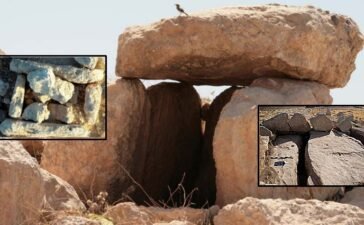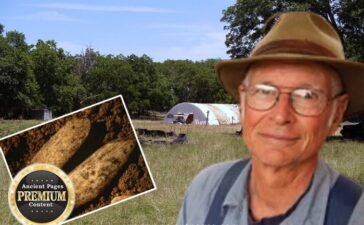New Denisovan Fossil: Extinct Humans Inhabited Tibetan Plateau For 160, 000 Years – Study

Conny Waters – AncientPages.com – Bone remains found in a high-altitude Tibetan cave (3,280 m above sea level) indicate that an ancient group of humans survived here for millennia.
Examples of anthropogenically modified faunal specimens and bone tools. Credit: Nature (2024). DOI: 10.1038/s41586-024-07612-9
Denisovans were an extinct human species that coexisted with Neanderthals and Homo sapiens. Archaeologists have found only a few Denisovan remains.
Evidence suggests the group interbred with Neanderthals and Homo sapiens, but little else is known about them, including their extinction date.
A research team from Chinese and Danish institutions studied over 2, 500 bones from the Baishiya Karst Cave on the Tibetan Plateau, one of two known Denisovan habitation sites.
The Xiahe 2 specimen, a Homo sp. rib specimen discovered through ZooMS screening. Credit: Nature (2024). DOI: 10.1038/s41586-024-07612-9
A new analysis has identified a Denisovan fossil, revealing the species’ adaptability to varying climates on the Tibetan plateau from 200, 000 to 40, 000 years ago, including during the ice age.
Dr. Geoff Smith, a University of Reading zooarchaeologist and study co-author, stated, “We identified that Denisovans hunted and ate various animal species. This reveals their adaptation to high altitudes and changing climates. We’re just starting to understand this extraordinary human species’ behavior.”
Bone fragments from Baishya Karst Cave were unidentifiable. The team used a new method analyzing collagen differences to determine the species of origin.
Dr. Huan Xia from Lanzhou University stated, “ZooMS extracts valuable information from bone fragments, offering deeper insight into human activities.”
The research team identified bones primarily from blue sheep (bharal) and wild yaks, along with equids, wooly rhinos, and spotted hyenas. They also found fragments from small mammals like marmots and birds.
Dr. Jian Wang from Lanzhou University stated, “Evidence indicates Denisovans occupied the cave, efficiently using all available animal resources during their stay.”
Analysis of bone surfaces reveals Denisovans extracted meat and marrow, and used the bones to make tools.
Scientists also identified one rib bone from a new Denisovan individual. Found in a layer dated 48, 000-32, 000 years ago, this suggests the Denisovan lived during modern human dispersal across Eurasia.
Denisovans survived two cold periods and a warmer interglacial period between the Middle and Late Pleistocene eras.
The fossil and molecular evidence suggests that Ganjia Basin, home to Baishiya Karst Cave, offered a stable environment for Denisovans, despite its high altitude, according to Dr. Frido Welker, of the University of Copenhagen.
“The question now arises when and why these Denisovans on the Tibetan Plateau went extinct.”
Written by Conny Waters – AncientPages.com Staff Writer
You Might Also Like
Ancient Secrets Of The Lost Megalithic City Of Nhambiquaras In The Amazon Jungle
Ellen Lloyd - AncientPages.com - In recent years, the discovery of ancient cities hidden within the Amazon Jungle has been...
5,500-Year-Old Ceremonial Site Of Murayghat Discovered in Jordan
Conny Waters - AncientPages.com - A research team from the University of Copenhagen has made a significant discovery at Murayghat...
Fascinating Ancient Artifact Discovered In Georgia Confirms Native American Legend Of A Great Catastrophe And Contact With Pre-Columbian Visitors
Ellen Lloyd - AncientPages.com - The accidental discovery of a fascinating and rare ancient artifact in Georgia, North America, invites...
Archaeologists Uncover A 20,000-Year-Old Secret That Rewrites The Ancient History Of North America Forever
Ellen Lloyd - AncientPages.com - The ancient history of North America is more thrilling than ever, urging us to reconsider...











